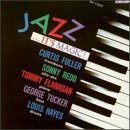| All Artists: Curtis Fuller Title: Jazz It's Magic Members Wishing: 1 Total Copies: 0 Label: Savoy Jazz Original Release Date: 3/19/1996 Re-Release Date: 3/26/1996 Album Type: Limited Edition, Original recording remastered Genres: Jazz, Pop Style: Bebop Number of Discs: 1 SwapaCD Credits: 1 UPC: 081757880725 |
Search - Curtis Fuller :: Jazz It's Magic
 | Curtis Fuller Jazz It's Magic Genres: Jazz, Pop
|
Larger Image |
CD Details |
CD ReviewsPrototypes in the development of hard bop Patricia Hennessy | USA | 07/09/2007 (5 out of 5 stars) "Trombonist Curtis Fuller's recordings for Savoy in the 1950s, like those of labelmates Hank Mobley, Milt Jackson, Wilbur Harden, Donald Byrd, and others, were prototypes in the development of hard bop. The next stage would come with the subsequent work of many of the same artists for Blue Note, where improved recording technique, greater attention to writing and arranging, and a more generous policy with respect to preparation and rehearsal time helped bring in the classic hard bop era of the late '50s and early '60s. On Fuller's Jazz...It's Magic, the hard bop prototype is still under refinement, but it's easy to enjoy the music in its essential elements: elegant, bluesy melodies; earthy, yet sophisticated, solo work; and fresh treatments of standards. For this 1957 date, Fuller is joined by the appealingly urbane Tommy Flanagan (piano), the versatile Louis Hayes (drums), and George Tucker (bass), whose loping but solid style resembles Paul Chambers'. Joining the trombonist in the frontline is the relatively obscure alto player Sonny Red, who has a clean, expressive, melodic approach to the Charlie Parker legacy that provides many of this CD's best moments. Three Fuller originals, Frank Foster's "Upper Berth," and a medley of ballad standards make up the program. If there are any misgivings about the CD, it would be the long medley (over 13 minutes), which drags on the overall pace. That said, Red's and Flanagan's solo spots on the medley are superb, but the listener's attention can be expected to wander by the time the trombonist finally steps up for his three choruses.
" |

 Track Listings (5) - Disc #1
Track Listings (5) - Disc #1